We discussed three types of relationships between objects: association, composition, and aggregation. However, we have not fully specified our chess set, and these tools don't seem to give us all the power we need. We discussed the possibility that a player might be a human or it might be a piece of software featuring artificial intelligence. It doesn't seem right to say that a player is associated with a human, or that the artificial intelligence implementation is part of the player object. What we really need is the ability to say that Deep Blue is a player, or that Gary Kasparov is a player.
The is a relationship is formed by inheritance. Inheritance is the most famous, well-known, and over-used relationship in object-oriented programming. Inheritance is sort of like a family tree. My grandfather's last name was Phillips and my father inherited that name. I inherited it from him. In object-oriented programming, instead of inheriting features and behaviors from a person, one class can inherit attributes and methods from another class.
For example, there are 32 chess pieces in our chess set, but there are only six different types of pieces (pawns, rooks, bishops, knights, king, and queen), each of which behaves differently when it is moved. All of these classes of piece have properties, such as color and the chess set they are part of, but they also have unique shapes when drawn on the chess board, and make different moves. Let's see how the six types of pieces can inherit from a Piece class:

The hollow arrows indicate that the individual classes of pieces inherit from the Piece class. All the child classes automatically have a chess_set and color attribute inherited from the base class. Each piece provides a different shape property (to be drawn on the screen when rendering the board), and a different move method to move the piece to a new position on the board at each turn.
We actually know that all subclasses of the Piece class need to have a move method; otherwise, when the board tries to move the piece, it will get confused. It is possible that we would want to create a new version of the game of chess that has one additional piece (the wizard). Our current design will allow us to design this piece without giving it a move method. The board would then choke when it asked the piece to move itself.
We can fix this by creating a dummy move method on the Piece class. The subclasses can then override this method with a more specific implementation. The default implementation might, for example, pop up an error message that says That piece cannot be moved.
Overriding methods in subclasses allows very powerful object-oriented systems to be developed. For example, if we wanted to implement a Player class with artificial intelligence, we might provide a calculate_move method that takes a Board object and decides which piece to move where. A very basic class might randomly choose a piece and direction and move it accordingly. We could then override this method in a subclass with the Deep Blue implementation. The first class would be suitable for play against a raw beginner; the latter would challenge a grand master. The important thing is that other methods in the class, such as the ones that inform the board as to which move was chosen, need not be changed; this implementation can be shared between the two classes.
In the case of chess pieces, it doesn't really make sense to provide a default implementation of the move method. All we need to do is specify that the move method is required in any subclasses. This can be done by making Piece an abstract class with the move method declared abstract. Abstract methods basically say this:
Indeed, it is possible to make a class that does not implement any methods at all. Such a class would simply tell us what the class should do, but provides absolutely no advice on how to do it. In object-oriented parlance, such classes are called interfaces.



